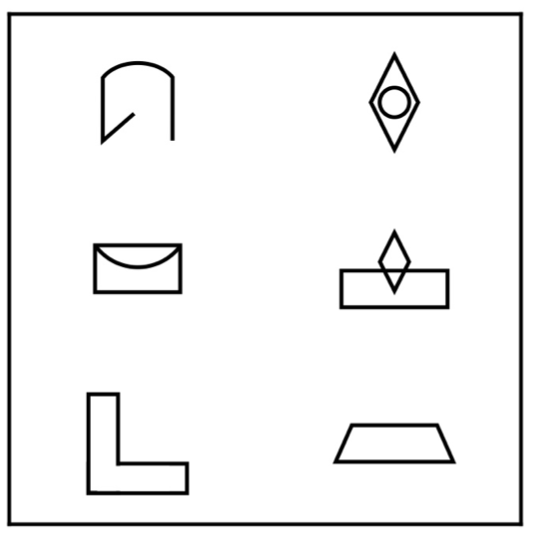Visuospatial memory

Figure: example of the brief visuospatial memory test stimuli.
The brief visuospatial memory test – revised [BVMT, 1] has been used as assessment for visuospatial domain of the memory ability.
The test scores are divided in recall memory (immediate/delayed) and additional learning and memory scores (learning, percentage retained, discrimination index, response bias, false alarm). The test material is an 8x11-inch plate containing six geometrical figures presented in a 2x3 matrix (as shown in the Figure above).
The patients are required to observe the figures in three consecutive trials lasting 10s each. The immediate recall task occurs at the end of the first trial, when the patients must draw the figures as accurately and fast as they can.
The figures are presented again in two following trials (learning trials) , at the end of which the patients are encouraged to improve their performance. After a delay of 25m, the delayed recall task is administered, during which the patients are instructed to reproduce the figures matrix by memory.
Finally, in the delayed recognition task , the patients are presented with 12 drawings representing the six matrix figures (target) and six foil figures (nontarget). Patients are required to recognise the six matrix figures, responding “yes” when the target figures are presented and “no” when the non-target figures are shown.
| Score | Info |
|---|---|
| bvmt_bias | Figure bias (BVMT) |
| bvmt_delay | Figure delayed recall (BVMT) |
| bvmt_delayt | Figure delayed recall t-score (BVMT) |
| bvmt_discrim | Figure recognition discrimination (BVMT) |
| bvmt_fa | Figure false alarm (BVMT) |
| bvmt_hit | Figure recognition hit (BVMT) |
| bvmt_im | Figure immediate recall (BVMT) |
| bvmt_imt | Figure immediate recall t-score (BVMT) |
| bvmt_learn | Figure learning (BVMT) |
| bvmt_perc | Figure percent retained (BVMT) |
BVMT=Brief Visuospatial Memory Test-revised.
1. Benedict, R.H.B., et al., Revision of the Brief Visuospatial Memory Test: Studies of normal performance, reliability, and validity. Psychological Assessment, 1996. 8: p. 145–153.